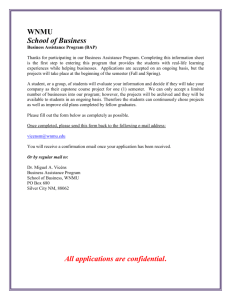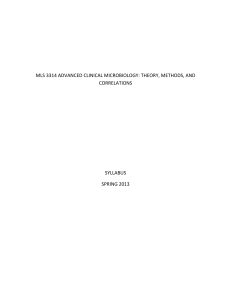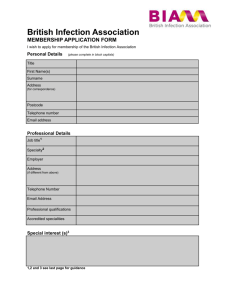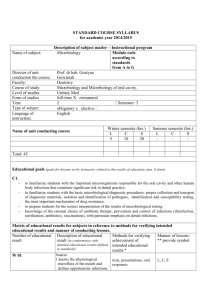BIOL 371 CRN 10286 - Western New Mexico University
advertisement
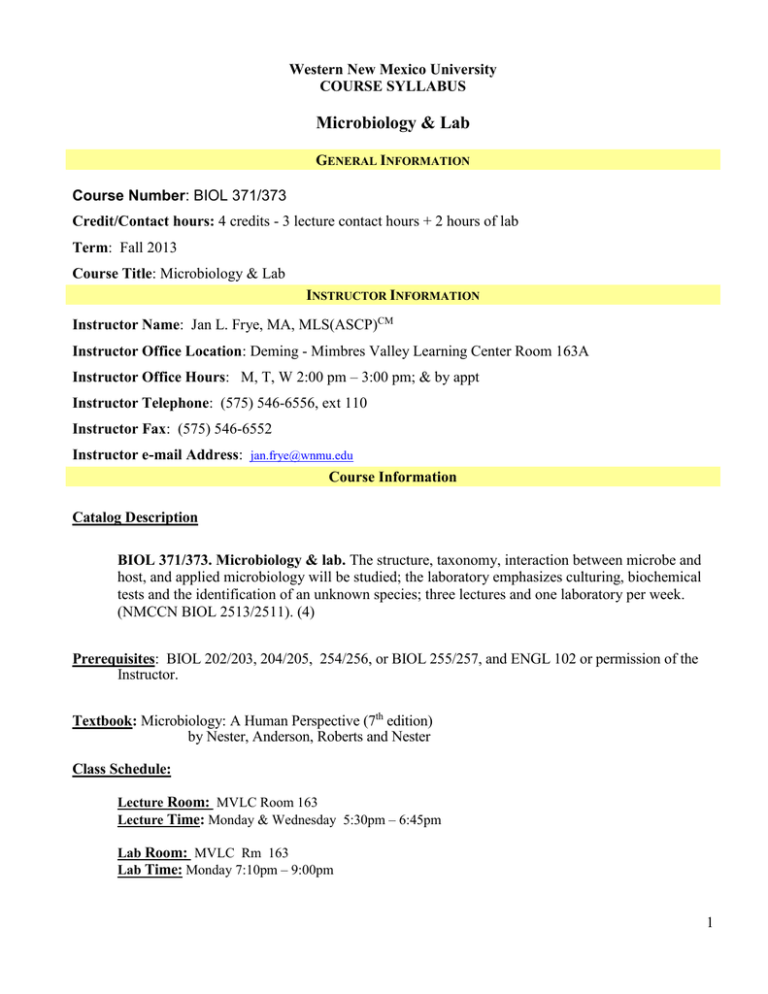
Western New Mexico University COURSE SYLLABUS Microbiology & Lab GENERAL INFORMATION Course Number: BIOL 371/373 Credit/Contact hours: 4 credits - 3 lecture contact hours + 2 hours of lab Term: Fall 2013 Course Title: Microbiology & Lab INSTRUCTOR INFORMATION Instructor Name: Jan L. Frye, MA, MLS(ASCP)CM Instructor Office Location: Deming - Mimbres Valley Learning Center Room 163A Instructor Office Hours: M, T, W 2:00 pm – 3:00 pm; & by appt Instructor Telephone: (575) 546-6556, ext 110 Instructor Fax: (575) 546-6552 Instructor e-mail Address: jan.frye@wnmu.edu Course Information Catalog Description BIOL 371/373. Microbiology & lab. The structure, taxonomy, interaction between microbe and host, and applied microbiology will be studied; the laboratory emphasizes culturing, biochemical tests and the identification of an unknown species; three lectures and one laboratory per week. (NMCCN BIOL 2513/2511). (4) Prerequisites: BIOL 202/203, 204/205, 254/256, or BIOL 255/257, and ENGL 102 or permission of the Instructor. Textbook: Microbiology: A Human Perspective (7th edition) by Nester, Anderson, Roberts and Nester Class Schedule: Lecture Room: MVLC Room 163 Lecture Time: Monday & Wednesday 5:30pm – 6:45pm Lab Room: MVLC Rm 163 Lab Time: Monday 7:10pm – 9:00pm 1 Course Objectives and Outcomes Course Instructional Objectives: I. The ability to comprehend and communicate the underlying theories that describe scientific and/or quantitative inquiry related to microbiology. II. The ability to employ critical thought processes, the scientific method and technology to determine solutions to problems related to microbiology. III. The ability of students to effectively communicate scientific and/or quantitative information related to microbiology. IV. The ability to understand and master microbiology laboratory techniques and safety protocols. Course Outcomes or Competencies: I. Students will understand the scientific process and apply it to problems related to microbiology. II. Students will comprehend and be able to use appropriate terminology to describe and explain anatomical structures and physiological processes related to microbiology. III. Students will be able to apply the scientific method and their knowledge of microbe anatomy and physiology to the explain the effects of different diseases on the functioning of body systems. IV. Students will be able to use quantitative methods to analyze microbial problems and be able to evaluate the significance of results. V. Students will be able to use appropriate technology to collect data, evaluate information and present results of analysis of problems related to microbiology. VI. Students will understand and be able to discuss ethical issues related to microbial research and diseases. VII. Students will understand microbiological laboratory techniques, their applications and safety precautions associated with their use. VIII. Students will know how to maintain a safe laboratory working environment when working with microbes. Upon completion of this course the successful student will have an introduction and understanding of basic biological concepts including the scientific method, diversity and properties of life, evolution, cell biology and human anatomy and physiology. 2 Course Topics, Evaluation and Grading Scale TOPICS TO BE COVERED Tentative LECTURE OUTLINE Chapters Topics 1. What is microbiology? 2. Introduction to microbiology/ Epidemiology 1 1, 19 3. Types and uses of microscopes Classification / size Biological Molecules / Protein synthesis 3 (pages 39-46) 4. Overview of major groups of microorganisms –Bacteria Methods of Identification / Characteristics 10, 11 5. Overview of major groups of microorganisms – Bacteria 3, 4 2, 7 6. Overview of major groups of microorganisms –Eukaryotes 12 7. Overview of major groups of microorganisms – Viruses 13 8. Metabolism / Microbial respiration Immune system and microbiology 6 14, 15, 16, 17, 18 9. Immune system and microbiology 14, 15, 16, 17, 18 10. Control of microorganism growth 5 11. Antibiotics and antimicrobial mediations Epidemiology 20 19 12. Skin infections Upper respiratory system infections Lower respiratory system infections 22 21 21 13. Upper GI track infections Lower GI track infections 24 24 14. Urinary track – reproductive system infections Nervous system infections Wound infections 25/ 28 26 23 15. Lymphatic system – blood infections – Review for final 27 Exam 1: Monday, Sept 16, 2013 Exam 2: Wednesday, October 16th, 2013 Exam 3: Monday, November 18th, 2013. Final Exam: Monday, December 9, 2013 from 4:00 – 6:00pm There will be a review for each test the week or class prior to the examination. Fall break Nov 25 – 29th 3 Grading Scale and Policy: Grading Policy: 90%-100% = A 80%- 89% = B 70%- 79% = C 60%- 69% = D 59%- below = F Note: grades are based on the percentage of the possible points that a student obtains. Lecture Possible Points Exam 1 Exam 2 Exam 3 Final Exam Attendance Total possible 100 pts. 100 pts. 100 pts. 100 pts. 30 pts. 430 pts. Note: Your lowest score on exams 1, 2, 3, will be improved by your score on your final if you do better on the final exam. The lowest and final scores will be added together and averaged. The average score will replace the lowest score. Lab Possible Points Lab quizzes (depends on number) Lab Unknowns Lab Notebook Lab Attendance Research Project Presentation Total possible 30 pts 30 pts 60 pts 30 pts 50 pts 200 pts. Note, your grades for lab and lecture will be combined into one composite grade, so you will end up with the same grade in lab and lecture. Total possible points in the course = 630 Instructor’s Expectation: Attendance/ Absence Policy: It is expected that students will attend all lectures and labs. Past history suggests that students who do not attend class regularly do not perform well on exams and in the course as a whole. An attendance sheet will be kept for each day of class. Students who are not present will not receive the points unless it is preapproved or you have a note from your doctor. Lab Attendance: Students who are not present will only receive the points if they make up the lab. If you miss a lab, you will receive a 0 for that lab. If you miss a second lab you must contact the instructor for a make-up lab. If you can’t speak with me personally, you may leave a message on my answering machine stating that you wish to make up a lab. Please leave a phone number where you may be contacted. I may request an excuse slip before allowing the make-up. It is your responsibility to schedule a make-up. University policy states that the instructor of a lab may drop you after two unexcused absences. Late Assignment Policy: Late assignments will lose 20% of the points possible for each class period they are late. 4 Make-up Exam Policy: Students will only be allowed to take a make-up exam by arranging it prior to the date/time of the exam (i.e., you must talk to me outside of class) or when you have a note from your doctor. Exams are usually handed back the class after the exam is taken. *** NO make-up exams can be taken after the exam has been passed back to the class.*** Note, I plan to strictly enforce the above policy! Cell Phone Policy: Student cell phones should be turned off when they are in class. Students should not make or answer phone calls in class. Tests, Quizzes, and Final Examinations: Lecture Exams 1, 2, 3: These exams will include questions from lecture material. Exams will include matching, diagram labeling, multiple choice, and short answer essay questions. Final Exam:. Monday, December 9, 2013 from 4-6 pm The final exam will consist of 100 multiple-choice or matching questions. These questions will come from all of the material presented in lab and lecture during the course. (Tentatively) these questions will come from the following sections of the course: -Microbiology introduction (previous material) -Overview of major groups of microorganisms (previous material) -Control of microorganism growth (new material) -Antibiotics and antimicrobial medications (new material) And the specific diseases below: Skin infections -Chicken pox -Measles -Rubella (German measles) -Small pox Upper respiratory infections -Strep throat -Diphtheria -Common cold Lower respiratory infections -Bacterial pneumonia (Pneumoccal) -Whooping cough -Tuberculosis -Influenza Upper GI infections -Gastritis + Ulcers -Mumps Lower GI infections -Cholera -Shigellosis (Shingella dysentery) -Typhoid fever -Hepatitis A-G -Amoebic dysentery 5 Urinary/ reproductive infections -AIDS Nervous system infections -Leprosy -Polio Wound infections Lymphatic/ blood infections -Bubonic plague -Mononucleosis -Yellow fever *Note: Any evidence of cheating on any exam will result in a grade of "F" for the course. Exam Policies: -You can only have a pencil or a pen and a drink during the exam (No other materials are to be on the desktop) -No cell phones are to be out or in your pocket during an exam *** You may not answer you cell phone during an exam -Do not have any papers in your pockets during the exam -Go to the bathroom before the exam starts – no student will be allowed to leave the room once the exam starts -If you arrive more than 15 minutes late for an exam you, you will not be allowed to take the exam unless prior arrangements are made Lab unknowns: Lab unknowns will be interpretation of gram stains and other stains and identifying bacteria cultures using biochemical tests and staining. Lab note book: During the course, students will assemble a lab notebook with all their labs in it and all their lab worksheets (completed). The notebook should be arranged in the order labs were done in the course with the lab hand out first followed by the lab worksheet if a worksheet was used. Projects: Each student group (2 students) will research a disease and create a summary handout on the disease and prepare a 25 minute oral/ IT presentation on the topic. Students may choose one of the diseases below or propose another disease. Topics proposed by students must be approved by the professor. The handout (3-8 pages) should be in outline format like the notes and should cover aspects of the disease not presented in my notes. The presentation should cover the following: causative agent, characteristics/ identification of the causative agent, site of infection, disease symptoms and stages, incubation period, mode of transmission, vectors and reservoir hosts, distribution, morbidity and mortality related to the disease, history of the disease and major past epidemics, control and treatment of the disease, interesting things about the disease. All references used should be given at the end of the handout. Suggested Topics: -Malaria*** -Rocky mountain spotted fever -Ringworm, jock itch, athlete’s foot -Thrush (Candidiasis) -Klebsiella pneumonia -Hantavirus pulmonary syndrome -Severe acute respiratory syndrome (Sars) -Coccidioidomycosis and Histoplasmosis -Dental plaque and cavities 6 -Cold sores, fever blisters, herpes simplex libialis -Gastroenteritis, traveler’s diarrhea, Delhi belly, Montexuma’s revenge, turkey trots -Botulism -St. Anthony’s fire -Giardiasis -Bladder infections -Gonorrhea -Chlamydia -Syphilis -Meningococcal meningitis -Bacterial meningitis -Viral encephalitis -Chronic sleeping sickness -Acute sleeping sickness -Staphylococcal wound infections -Flesh eating bacteria -Tetanus -Acute and sub acute bacterial endocarditis -Tularemia -Brucellosis, undulate fever, bang’s disease -Dengue, brakebone fever, dandy fever -Ebola -Rift valley fever -Toxoplasmosis -Dum dum fever, kala-azar and Leishmaniasis Grading: Presentation - - - - - - - -- - - - - - - - - - - - - - - - - - -10 Points Summary Handout - - - - - - - - - - - - - - - - - - - - - 10 Points References - - - - - - - - - - - - - - - - - - - - - - - - - - 5 Points Research quality and information presented - - - - - 25 Points Total 50 Points **** Grading will be based in part on peer evaluations Students with Disabilities: Services for students with disabilities are provided through the Academic Support Center’s Disability Services Office in the Juan Chacon Building, Room 220. Some examples of the assistance provided are: audio materials for the blind or dyslexic, note takers, readers, campus guides, audio recorders, a quiet testing area, and undergraduate academic tutors. In order to qualify for these services, documentation must be provided by qualified professionals on an annual basis. Disability Services forms are available in the Academic Support Center. The Disability Services Office, in conjunction with the Academic Support Center, serves as Western New Mexico University's liaison for students with disabilities. The Academic Support Center’s Disability Services Office can be contacted by phone at 575.538.6400 or e-mail at matterr@wnmu.edu. Communication Policy Statement Regarding Official E-mail : WNMU’s policy requires that all official communication be sent via Mustang Express. As a result, all emails related to your enrollment at WNMU and class communication – including changes in assignments and grades – will be sent to your wnmu.edu email address. It is very important that you access your Mustang Express e-mail periodically to 7 check for correspondence from the University. If you receive most of your email at a different address you can forward your messages from Mustang Express to your other address. Example: Martin Classmember was assigned a WNMU email address of classmemberm12@wnmu.edu but Martin would rather receive his emails at his home email address of martinclass@yahoo.com Martin would follow the direction provided at http://www.wnmu.edu/campusdocs/direction%20for%20forwarding%20email.htm WNMU Policy on Email Passwords: WNMU requires that passwords for access to all of the protected software, programs, and applications will be robust, including complexity in the number of characters required, the combination of characters required, and the frequency in which passwords are required to be changed. Minimum complexity shall include: Passwords shall contain at least six (6) characters. Passwords shall contain at least one capital (upper case) letter, and at least one symbol (numbers and characters such as @ # $ % & *). Passwords shall be changed at least every 90 days. (8/6/08) Academic Integrity: Each student shall observe standards of honesty and integrity in academic work as defined in the WNMU catalog. Violations of academic integrity include “any behavior that misrepresents of falsifies a student’s knowledge, skills or ability with the goal of unjustified or illegitimate evaluation or gain” (WNMU Faculty Handbook, 2008). Generally violations of the academic integrity include cheating and plagiarism. Refer to the catalog for definitions. Plagiarism: “the intentional or unintentional representation of another’s work as one’s own without proper acknowledgement of the original author or creator of the work” (WNMU Faculty Handbook, 2008) Penalties: Student will receive a grade of zero on the assignment. Cheating: “using or attempting to use unauthorized materials…and unauthorized collaboration with others, copying the work of another or any action that presents the work of others to misrepresent the student’s knowledge” (WNMU Faculty Handbook, 2008) Penalties: Note: Any evidence of cheating on any exam will result in a grade of "F" for the course. Inclement Weather policy: Refer to the OTA Student Handbook for notification procedures. In the event that classes are closed during the scheduled final exam for this class, provisions for students whose exams are canceled will be made, by scheduling a make-up exam or making alternative arrangements. 8 Tentative LABORATORY OUTLINE WEEK -- LAB TOPIC 1. Lab safety and protocols (page 1) 2. Lab 1: Microscope use (page 3) -Microscope use -Achieving critical focus -Using oil immersion 3. Lab 2: Methods for working with bacteria (page 13) -Bacterial identification methods -Colony morphology -Shape, size and arrangement -Staining characteristics -Biochemical tests -Growth on different types of media 1-6 70-75 36-43 95-99 100-125 42-45 -Definition of media types -Nutrient, selective, differential and enriched media -Fundamental skills for working with bacterial 17-27, 433-435 -Moving bacteria loops, needles and glass spreading rods -Aseptic bacterial transfer -Use of different media types (plates, slants, deep and broth) -Labeling and incubation of media -Disposal of used plates -Hand washing experiment -Practice with different types of media 4. Lab 3: Simple staining, negative staining, hanging drop motility and flagella stain (page 23) -Bacteria colony morphology and color (demonstration plates) - Review 30-39 -Making bacteria slides from living bacteria -Simple staining (oil emersion review) -Bacterial shapes and arrangements -Negative stains -Hanging drop motility -Flagella stain 100-102 103-10 122-123 124-125 5. Lab 4: differential staining (Gram and Acid Fast) –capsule stain and endospore stain (page 28) -Differential stains -Gram stain -Acid fast stain -Capsule stain -Endospore stain 105-109 110-114 115-116 117-120 6. Review of Differential stains Lab 5: Single colony isolation – Differential staining review (Page 35) Single colony isolation -Streak method 25-28 -Serial dilution 29-31 7. **Lab quiz – Bacteria morphology and staining (Page 38)** **Lab quiz – Single colony isolation results** 8. Lab 6: Selective –Differential media (Page 39) -Selective - differential media -Mannitol salt agar -Phenylethyl alcohol agar -EMB Agar 137-138 131-132 142-143 9. Lab 7: Differential tests (catalas, oxidase, citrate, O/F glucose, MR/VP) –(Page 43) -Catalase 165-167 -Cytochrome oxidase 168-170 -Citrate 175-176 -O/F glucose 155-157 -Methyl red and Vogues -Proskauer 161-164 10. Lab 8: Differential tests (starch hydrolysis, urease, gelatinase, bood agar, mobilitiy test) –(Page 49) -Starch hydrolysis 184-186 -Urease test 187-189 -Gelatinase test 192-193 -Blood Agar (alpha and beta hemolysis) 217-219 -Mobility test 224-225 11. Lab 9: Unknown identification (Page 54) -Bacterial unknowns -Demonstration (fermentation and food) -Cheese / sauerkraut 12. -Work on Unknowns 13. -Unknown identifications due 14. Lab 11: Microbial stressors (Page 60) -Microbial stressors / antibiotic sensitivity **** Project presentations**** 15. Dec 9 **** Project presentations**** (Lecture Final Exam only) 226-241/ 278-294 268-270
